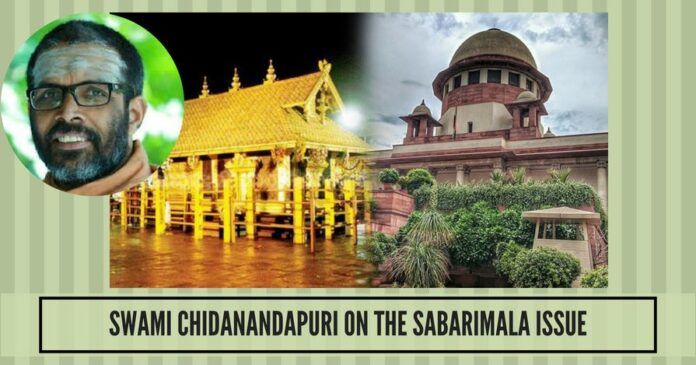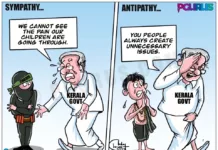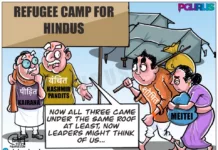
Sabarimala is in the news as the Supreme Court is hearing the petition filed with it on allowing women entry into the temple
The #ReadyToWait campaign has again been activated in order to let the honourable judges know that Hindu stakeholders do not want the Supreme Court to decide on their behalf.
This is a translation of Swami Chidanandapuri’s views on the issue. The SC would do well to take heed of the voices from the ordinary stakeholders contributing to the #ReadyToWait campaign as well as learned and respected exemplars from the tradition.
This is a translation of a recent talk given by swamiji on the issue.
Sabarimala has helped Hindu society in no small measure to empower and unify them. It has been the reason in a very big way to prevent rampant conversions to other faiths. This is not all. Sabarimala is the one pilgrimage centre that attracts the most pilgrimage tourists. For a long time now, Sabarimala has been dragged from one controversy to another.
The people who have the right to talk about our ways of worship and the rituals to be followed in our temples, are experts in the vedas, tantra sastra and devotees.
From rat’s tail (reference is to rat’s tail found in the aravana payasam prasad given there), Jayamala issue (actress who claimed she entered Sabarimala when she was 27, thereby violating the existing rules of the temple), the Mullaperiyar dam controversy (that it will burst soon), there have been numerous controversies besieging this temple. However, these controversies were only trying to dislodge small foundational stones (metaphorical) of the temple. Such incidents have not caused harm to the hindu society so far and neither will they do so in the future.
However, these incidents have systematically and slowly interfered and tried to subvert an entire community’s temple’s belief and worship systems. These incidents have been amplified and very intelligently been taken forward to endanger the temple and its devotees.
As part of this campaign it is now being posited that not allowing women entry into the temple is a violation of their rights and hence that they should be allowed to enter. The pretext for this demand is that men and women are equal under the law. Since men and women are equal under the law and because worship is a fundamental right for both, women must be allowed to enter the temple. This is the issue at hand.
What is important to note here is whether this matter has been brought to the court by a temple devotee. To this, the answer is a resounding no. If one has to elaborate further, the person who petitioned the Supreme Court on this issue is an advocate who is a Muslim by faith. Then others also joined. But what I have to say is that it is only the Hindu’s way of worship and a temple’s worship rites and rituals that are subject to this scrutiny. In the name of fundamental rights etc, only Hindus are targeted, and when a secular government and its secular judicial arm discusses only Hindu rites and rituals, it is pertinent to ask why ways of worship or rites and rituals from other faiths are not being questioned.
If this is a case of equal rights of women and of disrespect to them, there is only one Sabarimala. There is not a single Sunni mosque into which women are allowed entry. There are tens of thousands of Sunni mosques. There is no question of fundamental rights of the woman in this case and that is of course not an issue for the court to deliberate upon. In Mujahid mosques, yes women are allowed but into a small, segregated enclosure only. It is not a general right to enter anywhere and along with men on equal terms into the mosque. At religious discourses, men and women are not seated together. They sit behind a screened enclosure. There is obviously no fundamental right or equality issue in any of this. This is happening only in the case of the Sabarimala temple, and is taken as an issue of Hindu temples.
This is very wrong. The people who have the right to talk about our ways of worship and the rituals to be followed in our temples, are experts in the vedas, tantra sastra and devotees. It is not the secular court. If the court has the right, then it must also discuss the ways of worship of other faiths too.
A temple is a place where the faithful enter, respecting all the rites and rituals associated with the temple, to have a darshan of the deity inside
There is one more thing to be considered here. One of the observations of the respected court in this matter was to ask why a temple is not a public space. Let me state unambiguously and underline that a temple is NOT a public space. A temple is the aasthanam (abode) of the Hindu deity housed there. There are specific and particular rites and rituals for each temple and these have been coming down for generations. Each temple and the deity it is the abode of, has its own particular conceptions, beliefs and legends along with the rites and rituals, entangled together for generations. To honour those in letter and spirit is not just the right of Hindus but indeed also the obligation.
The reason I say this is because in an earlier judgement of the same respected Supreme Court, they had declared that whichever denomination had established whichever temple, that denomination (using the same word “denomination” as the SC did) had the right and authority to conduct the affairs of that particular temple according to the rites and rituals prescribed for their deity.
In that case, in the issue of traditional ways of worship, different deities with different gunas, are consecrated in specific human form with by the acharyas and priests and are being worshipped as centres of shakti through generations. Hence that speciality of the particular temple has to be protected. For example, a sanyasi is person who does not worship in a temple. However, it is considered to be very auspicious if a sanyasi enters a temple. However, there are temples which do not allow a sanyasi inside. There are temples which have to be subjected to a purification ritual if a sanyasi has entered it. There are temples in Kerala itself, for example, the Payyannur Subramanya Swami Temple. So what I am trying to say is that there are certain unassailable belief systems in every temple.
There are temples where only mothers do puja. Men are not the main pujaris in such temples, for example, in Mannarshala. As part of worship, there are temples where two sections of society are made to fight with each other as part of the ritualistic rites. The essence of all this is to emphasize that different temples have different ritualistic ways and these have to be respected and protected. In the case of Sabarimala, it is not that women cannot enter, the restriction is only on women in the reproductive age not entering. That has been the traditional way of the temple.
If you ask me whether that way should not be modified for the times, in my personal capacity I would say yes. However, who should change these? It definitely is not the secular government. It should be the tantris, the veda experts and the devotees who come to Sabarimala and in particular, the women devotees of Swami Ayyappa who all have to sit together to deliberate on the issue. This should be unambiguously and strongly asserted by Hindu society.
From about 8:43 – 11:14, there is an audio problem.
There is another important point to be considered finally. It is stated that right to worship is a fundamental right. If a person claims that the right to worship is his/her fundamental right, it is correct. If a person is chanting the name of his ishtadevata in the privacy of his/her home, surely, that is his/her fundamental right.
A temple is not only a centre for worship. We go there for a darshan of the deity also. In the case of a temple, it is darshan of the deity that is the primary reason for visiting a temple. Having darshan of the deity is not a fundamental right.
A person says it is his fundamental right to chant. Yes, that it is, as long as he does not cause a disturbance to others with his chanting. If he does not use a mike to chant and cause nuisance to others, he is certainly within his rights to call it his fundamental right. However, if he is causing disturbance to the general public at large by chanting using large mikes which transmit loudly, then the public is well within its right to restrain the person from doing so. However, darshan of a deity is not a fundamental right.
Suppose someone said that they wanted to see Swami Chidanandapuri, he cannot claim that as his fundamental right. This is because if the swami is engaged in other work and has other things to attend to when this person wants to see him, he cannot demand audience with the swami as his fundamental right. In the temple, the deity is consecrated as a human form. So, when it is in this form, it is associated with certain conditions. There are specific dos and donts. According to this, the temple deity has to be looked at within the ambit of those conditions. One cannot barge into a temple just like that and claim that it is a fundamental right.
It may be that the deity has been put to sleep for the day. Can a person claim that he still wants to have a darshan of the deity? Before waking up the deity, a person who is not someone who does the puja cannot go into the temple. There are definite rules. That is the reason why right to worship is a fundamental right but right to have darshan is not. The rules for darshan is particular to each temple deity and has to be respected.
When seen in this light, one has to take into account the significance of each sign and symbol of a temple’s ways and then only decisions should be taken.
To consolidate and summarise, let me state this. Firstly, this is not an issue for a secular court to take up. If it is, then let the court decide the ways for all religions. Only Hindu ways of worship becoming a subject for the court to deliberate upon, leaving aside worship ways of other faiths, is not acceptable. By saying this emphatically, I am not saying that things should not be changed. They can and should be changed because these are all issues of smriti, not shruti. Shruti will never change, smriti will. However, that change is if it is the case of Islamic ways of worship (not societal norms), should be done by Muslim experts, if it is the ways of worship of Christians, it should be done by Christian experts and if it is the case of Hindus, then it is the Hindu experts who should take the decisions. In keeping with the changing times, Hindu smritis have to be updated and through this changed smritis only, the change has to come.
Going forward in any other sense is very harmful and especially, the observation of the court that the temple is a public space is very dangerous. Let me emphatically state that a temple is NOT a public space. A temple is a place where the faithful enter, respecting all the rites and rituals associated with the temple, to have a darshan of the deity inside. If it is decided that the temple is a public space that will be a very dangerous situation tomorrow for all of Hindu Dharma and Bharat. There is absolutely no doubt about that and hence we should emphatically and unambiguously state that a temple is not a public space.
Source:
ശബരിമല വിഷയത്തിൽ ശ്രീമത് ചിദാനന്ദപുരി സ്വാമികൾ പ്രതികരിക്കുന്നു.
Posted by Veda Chaithanya on Saturday, July 21, 2018
- Prime Minister Narendra Modi: A Gujju businessman who does not invest his precious time for a losing battle - April 13, 2024
- NIA arrests two accused Shazib and Taahaa in Bengaluru’s Rameshwaram Cafe blast case from Kolkata - April 12, 2024
- National Herald scam: Adjudicating Authority upholds Rs.752 crore assets attached by ED - April 11, 2024











I agree fully to the analysis find by Swamiji. The case has been presented badly, argued badly and hence a decision which is biased. In the review petition that is going to take place, my sincere hote is all the points raised by Swamiji should be taken into consideration.
I agree totally with Swamijis analysis on women being disallowed in other faiths place of worship.
The biggest revelation of Capt Ajit Vadakayil is about Lord Ayyappa being the 9th Avatar of Lord Vishnu. How did we ever miss it?
Buddha a mere mortal who struggled for enlightenment is not the 9th Avatar of Lord Vishnu, by any stretch of the imagination. Neither is Balarama, who is actually an incarnation of Anantha. So the 9th Avatar was always a mystery, never resolved until Capt Ajit Vadakayil made the big bang revelation in his blog.
Lord Ayyappa is not Hari Hara Puthra, but he is actually Hari Hara Sudhan – the beloved of the devotees of Hari and Hara. Mohini happened only during the Samudra Manthan, millenniums before Lord Ayyappa and during Kurma, the 2nd Avatar of Lord Vishnu. This is another case of poison injection and subterfuge of our history by the powers that be that ruled us for 800 years.
Lord Ayyappa then disappeared when he was a boy and re-appeared as Imhotep in Egypt. This was upon the express request and invitation of the then Pharaoh to resolve certain issues in his land. It was Imhotep who designed and got the pyramids erected. The structure of the pyramids follow the principles of Vaastu. To know more just type into Google “Pyramids Vadakayil” and you will come across the mind blowing post “Secrets of Egyptian Pyramids Revealed” and you will get to read things you will never find anywhere.
If you are from Kerala or have been to Kerala during Onam and you know about Maveli, just pause to think why during Onam the Maveli is created like a pyramid. Maybe there will be a lightning flash in the mind and your understanding about our ancient Indian culture and times will undergo a metamorphotic change.
Very true.